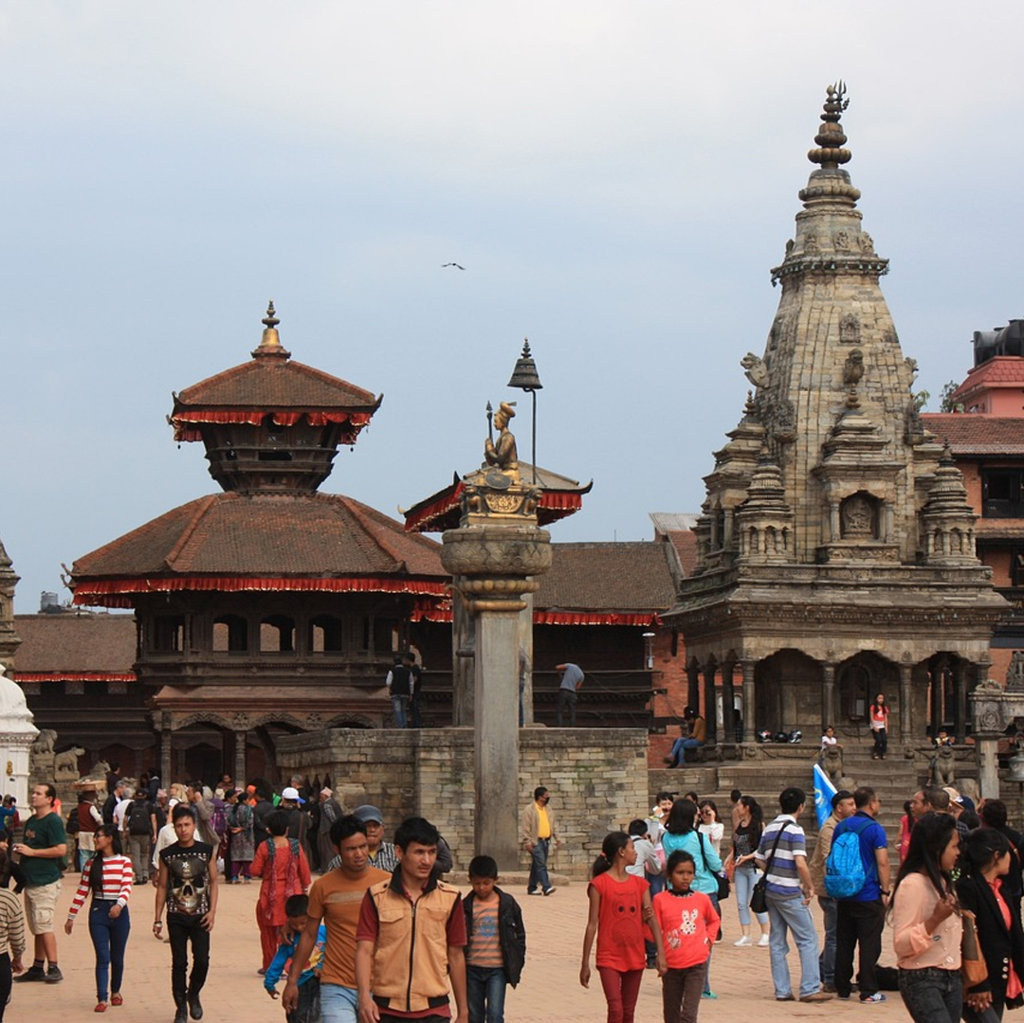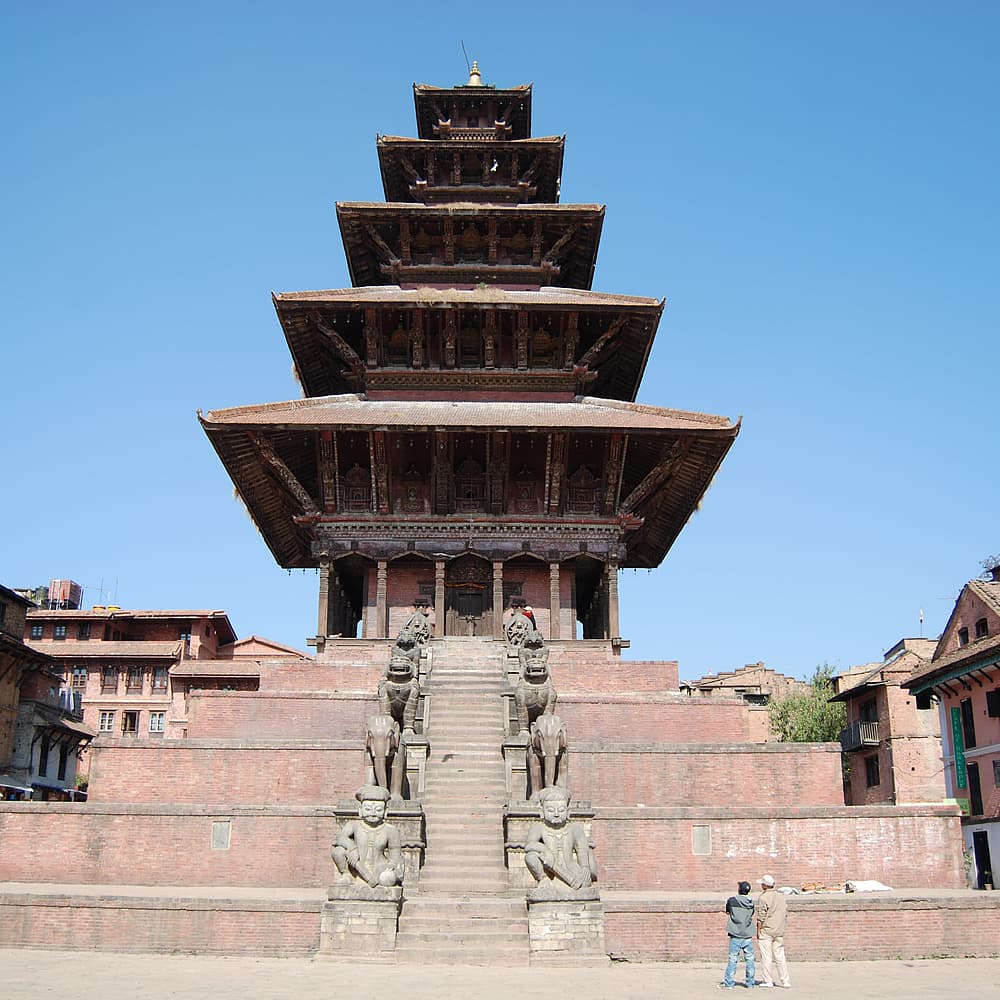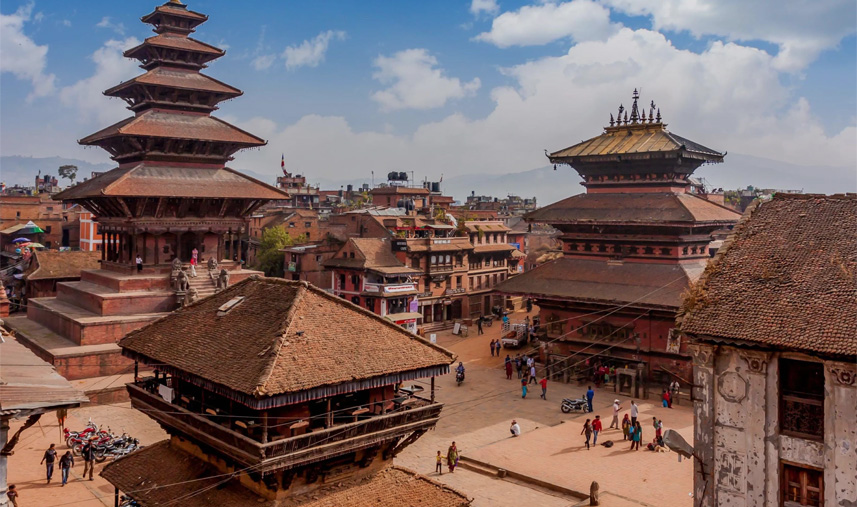Bhaktapur: Nepal's Medieval Masterpiece

Overview of Bhaktapur's historical significance
Bhaktapur, also known as Bhadgaon, is a city located in the Kathmandu Valley of Nepal. It is known for its rich cultural heritage, ancient architecture, and historical significance. Bhaktapur was once the capital of the Malla Kingdom, which ruled over the Kathmandu Valley from the 12th to the 15th century. Today, it is a UNESCO World Heritage Site and attracts tourists from around the world.
Thematic depiction of Bhaktapur's charm and cultural heritage
Bhaktapur is a city that charms and fascinates visitors with its unique blend of old-world charm and cultural heritage. The city is home to numerous temples, palaces, and courtyards that showcase the rich architectural style of the Malla period. The Durbar Square, with its stunning palaces and intricately carved wooden structures, is a prime example of Bhaktapur's cultural heritage.
Some of the main highlights of Bhaktapur's attractions include:
-
The Nyatapola Temple: This five-story pagoda-style temple is one of the tallest in Nepal and is dedicated to the goddess Siddhi Lakshmi. Its impressive structure and intricate carvings make it a must-visit for tourists.
-
The Bhaktapur Durbar Square: This ancient square is the heart of Bhaktapur and is surrounded by stunning palaces, temples, and courtyards. It is an architectural marvel that showcases the rich history and culture of the city.
-
The Pottery Square: This square is known for its pottery-making tradition, which has been passed down through generations. Visitors can witness the craft and even try their hand at pottery-making.
-
The Dattatreya Square: This square is dedicated to the Hindu deity Dattatreya and is a hub of religious and cultural activities. It is home to the famous Dattatreya Temple and other ancient structures.
In addition to these attractions, Bhaktapur is also known for its vibrant festivals, traditional Newari cuisine, and warm hospitality of its residents. Exploring the narrow lanes and admiring the traditional architecture is a delightful experience that transports visitors back in time.
Whether you are a history buff, an architecture enthusiast, or simply someone looking to experience the unique charm of a traditional Nepali city, Bhaktapur should be on your travel itinerary.

History of Bhaktapur
Ancient origins and founding of Bhaktapur
Bhaktapur has a long and fascinating history that dates back to ancient times. The city was founded in the 12th century by King Anandadeva Malla of the Malla Dynasty. Legend has it that he was searching for a suitable place to build a new city and came across a fertile land surrounded by eight mountains and blessed by eight different forms of the goddess. This idyllic location led to the formation of Bhaktapur, which translates to "City of Devotees."
Key historical events and rulers of Bhaktapur
Over the centuries, Bhaktapur grew in importance and became the capital of the powerful Malla Kingdom. The Malla rulers were known for their patronage of art, architecture, and culture, which contributed to the city's rich heritage. However, political rivalries and invasions led to the decline of Bhaktapur's power and influence.
One of the most significant events in Bhaktapur's history was the devastating earthquake of 1934, which caused widespread destruction to the city's temples, palaces, and buildings. The earthquake was a turning point that led to the preservation and restoration efforts that we see today.
The city's historical significance and unique cultural heritage led Bhaktapur to be recognized as a UNESCO World Heritage Site in 1979. This designation has helped in the preservation of its ancient buildings and traditions.
In summary, Bhaktapur's history is a tapestry of ancient origins, royal patronage, and resilience in the face of adversity. Today, the city stands as a living museum, offering visitors a glimpse into Nepal's glorious past.
- Ancient origins: Bhaktapur was founded in the 12th century by King Anandadeva Malla.
- Malla Dynasty: Bhaktapur served as the capital of the Malla Kingdom from the 12th to the 15th century.
- Devastating earthquake: The earthquake of 1934 caused significant damage to Bhaktapur's historical structures.
- UNESCO World Heritage Site: Bhaktapur was designated as a UNESCO World Heritage Site in 1979.
- Resilience and preservation: Efforts have been made to preserve and restore Bhaktapur's ancient buildings and cultural traditions.

Architecture and Monuments
Distinctive architectural styles in Bhaktapur
As you explore the streets of Bhaktapur, you will be captivated by the city's unique architectural styles. The buildings in Bhaktapur showcase a blend of ancient Newar craftsmanship and influences from Hindu and Buddhist traditions. Some of the distinctive architectural styles you will find in Bhaktapur include:
-
Pagoda Style: This style features multi-tiered roofs with intricate woodcarvings and exquisite details. The pagoda style can be seen in many of Bhaktapur's temples, including the iconic Nyatapola Temple.
-
Shikara Style: This style is characterized by tall and slender structures with pointed tops. The Shikara style is commonly seen in Hindu temples and can be admired in Bhaktapur's Siddhi Lakshmi Temple.
-
Bhaktapur Style: This style represents the traditional Newar architecture of the city. It is characterized by brick and timber structures with intricately carved windows, doors, and columns. The Bhaktapur style can be seen in the city's historic palaces and courtyard houses.
Notable monuments and their cultural significance
Bhaktapur is home to numerous culturally significant monuments that reflect the city's rich history and religious traditions. Some of the notable monuments in Bhaktapur include:
-
Durbar Square: This UNESCO World Heritage Site is the heart of Bhaktapur and is surrounded by numerous ancient temples, palaces, and courtyards. Durbar Square is a testament to the city's royal past and is a must-visit destination for history enthusiasts.
-
55 Window Palace: Built in the 15th century by King Yaksha Malla, this palace is famous for its intricately carved wooden windows. The palace served as the residence of the Malla rulers and offered a glimpse into their grandeur and opulence.
-
Nyatapola Temple: This five-story pagoda-style temple is one of the tallest and most beautiful structures in Bhaktapur. Dedicated to the goddess Siddhi Lakshmi, the temple is a symbol of strength and stability.
-
Dattatreya Temple: This temple is dedicated to the Hindu god Dattatreya and dates back to the 15th century. It is known for its woodcarvings and erotic stone carvings, which are believed to bring good luck and fertility.
These monuments not only showcase the architectural brilliance of Bhaktapur but also hold immense religious and cultural significance for the people of Nepal. You can explore these monuments and immerse yourself in the history and spirituality of Bhaktapur.

Arts and Crafts
Highlighting Bhaktapur's rich artistic traditions
When it comes to arts and crafts, Bhaktapur is a treasure trove of creativity. The city is known for its rich artistic traditions that have been passed down through generations. Here are some highlights of Bhaktapur's artistic heritage:
- Pottery: Pottery has been a significant part of Bhaktapur's culture for centuries. The skilled potters of Bhaktapur create beautiful clay pots, vases, and other pottery items using traditional techniques. You can witness these artisans at work in the city's pottery square and even try your hand at pottery making.
- Thangka Painting: Thangka painting is a traditional form of Tibetan Buddhist art that is popular in Bhaktapur. These intricate paintings, traditionally done on silk or cotton, depict Buddhist deities and symbols. Bhaktapur is home to several thangka painting schools and workshops where you can observe the artists at work and even take lessons.
- Woodcarving: Bhaktapur is renowned for its exquisite woodcarvings. Skilled craftsmen transform blocks of wood into intricate designs that adorn the city's temples, palaces, and buildings. Walking through the streets of Bhaktapur, you will come across numerous woodcarving workshops where you can witness this age-old art form in action.
- Thanka embroidery: Thanka embroidery is another traditional craft that is practised in Bhaktapur. This delicate embroidery technique involves stitching intricate designs on fabric using colourful threads. Thanka embroidered pieces often depict deities, mandalas, and religious symbols.
Exploring traditional crafts and artisan workshops
If you have a keen interest in traditional crafts, Bhaktapur offers you the opportunity to explore and learn from local artisans. Here are some artisan workshops you can visit:
| Artisan Workshop | Specialty |
|---|---|
| Pottery Square | Handmade pottery |
| Thangka Painting Schools | Thangka painting |
| Woodcarving Workshops | Exquisite woodcarvings |
| Thanka Embroidery Studios | Thanka embroidery |
Visiting these workshops will give you a firsthand experience of the craftsmanship and skills that go into creating these traditional crafts. You can observe the artisans at work, interact with them, and even purchase unique handmade souvenirs to take back home.

Temples and Sacred Sites
Glimpse into Bhaktapur's religious landmarks
When it comes to religious landmarks, Bhaktapur is a place steeped in spirituality. The city is home to numerous temples and sacred sites that hold immense cultural and historical significance. Here's a glimpse into Bhaktapur's religious landmarks:
- Durbar Square: The heart of Bhaktapur is Durbar Square, a UNESCO World Heritage Site. Here, you'll find an impressive collection of temples, pagodas, and palaces that showcase the city's architectural grandeur. The 55 Window Palace, Nyatapola Temple, and Bhairava Nath Temple are some of the must-visit sites in Durbar Square.
- Pashupatinath Temple: Located on the banks of the sacred Bagmati River, the Pashupatinath Temple is one of the most revered Hindu pilgrimage sites in Nepal. Dedicated to Lord Shiva, this temple complex attracts devotees from all over the world. It is not only a place of worship but also a centre for cultural and religious activities.
- Boudhanath Stupa: Just a short distance from Bhaktapur lies the iconic Boudhanath Stupa. This massive dome-shaped structure is one of the largest stupas in the world and holds immense significance for Tibetan Buddhists. Surrounding the stupa are numerous monasteries and shops selling Buddhist artefacts, making it a vibrant hub of Buddhist culture.
- Changu Narayan Temple: Situated on a hilltop overlooking Bhaktapur, Changu Narayan Temple is one of the oldest temples in Nepal. Dedicated to Lord Vishnu, this temple is renowned for its exquisite stone carvings and intricate sculptures. The temple complex also houses a museum where you can learn more about the history and artistry of Bhaktapur.
Detailed exploration of prominent temples and their significance
If you're looking to delve deeper into Bhaktapur's religious heritage, here are some prominent temples that you should explore:
| Temple | Significance |
|---|---|
| Nyatapola Temple | Considered one of the tallest pagodas in Nepal, this five-story temple is dedicated to the goddess Siddhi Lakshmi. It is a splendid example of Newa architecture and stands as a symbol of Bhaktapur's resilience and devotion. |
| Bhairava Nath Temple | Dedicated to the fierce deity Bhairava, this temple is known for its intricate woodcarvings and metalwork. It is believed to have been constructed to protect Bhaktapur from evil spirits. |
| Surya Vinayak Temple | This temple is dedicated to Lord Ganesh, the elephant-headed deity, and Lord Surya, the sun god. It is a popular pilgrimage site and offers breathtaking views of the surrounding landscape. |
| Changu Narayan Temple | As mentioned earlier, Changu Narayan Temple is not only significant for its age but also for its architectural marvels. It is believed to be one of the oldest surviving pagoda-style temples in Nepal. |
Exploring these temples will give you a deeper understanding of Bhaktapur's religious traditions, architectural excellence, and spiritual beliefs. Whether you're a history enthusiast or a spiritual seeker, Bhaktapur's temples and sacred sites offer a truly enriching experience. Don't miss the chance to witness the vibrant rituals, intricate artwork, and devotion that fill the air in this ancient city.

Traditional Festivals and Celebrations
Vivid depiction of Bhaktapur's vibrant festival culture
If you're looking to immerse yourself in the vibrant culture of Bhaktapur, exploring its traditional festivals and celebrations is a must. The city comes alive with colourful processions, lively music, and energetic dances during these festive occasions. Bhaktapur's rich cultural heritage and religious traditions are beautifully showcased through these celebrations, providing a glimpse into the local way of life and fostering a sense of community spirit.
Insights into major festivals and their rituals
Here are some major festivals celebrated in Bhaktapur and the significance behind them:
-
Bisket Jatra: This is one of the most popular and extravagant festivals in Bhaktapur. Celebrated in mid-April, Bisket Jatra marks the beginning of the Nepali New Year. The highlight of this festival is the pulling of chariots carrying the idols of Lord Bhairava and Goddess Bhadrakali. The chariot procession, accompanied by traditional music and dances, culminates in a tug-of-war competition between different communities.
-
Indra Jatra: Held in September, Indra Jatra is a festival dedicated to the deity Indra, the king of gods and the god of rain. The festival begins with the erection of a wooden pole, known as "lingo," in the centre of Bhaktapur's Durbar Square. Colourful masked dancers known as "laches" perform traditional dances while devotees pay their respects and offer prayers.
-
Bhairab Naach: This unique dance-drama is performed during the month of September. The participants wear elaborate costumes and masks depicting various deities and mythical characters. The dances portray stories from Hindu mythology and are believed to bring good fortune and ward off evil spirits.
-
Biska Jatra: This is a nine-day festival celebrated in April, during which the locals engage in traditional rituals, archery competitions, and the famous "tongue-pulling" ceremony. The highlight of Biska Jatra is the chariot procession that takes place on the ninth day, known as "Biska Din." Thousands of spectators gather to witness the chariot being pulled through the streets amidst cheers and festive fervour.
These festivals provide a unique opportunity to witness the cultural richness and religious devotion of Bhaktapur. They offer an immersive experience of the local traditions, where you can witness age-old rituals, enchanting dances, and vibrant celebrations. Participating in these festivals will truly make your visit to Bhaktapur an unforgettable one.

Local Cuisine
Discovering the unique flavours of Bhaktapur
If you're someone who loves exploring new culinary experiences, Bhaktapur has a delightful array of local cuisine waiting for you. The city is known for its delicious and distinctive dishes that showcase the flavours and ingredients of the region. From savoury snacks to mouthwatering sweets, Bhaktapur's food scene is sure to leave you satisfied and craving more.
Popular dishes and street food to try
Here are some must-try dishes and street food in Bhaktapur:
-
Juju Dhau (King Curd): This creamy and sweet yoghurt is a speciality of Bhaktapur. Made from buffalo milk, Juju Dhau is served in clay pots and has a velvety texture that melts in your mouth. The slightly tangy and rich taste of this yoghurt is truly a treat for the taste buds.
-
Sel Roti: This traditional Nepali rice bread is a popular snack in Bhaktapur. Made from a mixture of rice flour, sugar, ghee, and cardamom, Sel Roti is deep-fried until it turns crispy and golden brown. It is often enjoyed with a cup of hot tea or served as a dessert.
-
Chatamari: Known as the Nepali pizza, Chatamari is a thin rice pancake topped with a variety of ingredients like minced meat, eggs, vegetables, and spices. It is cooked on a hot griddle and served with chutney or yoghurt. This flavorful and filling snack is perfect for satisfying your cravings.
-
Yomari: Yomari is a delicacy made during the Yomari Punhi festival in Bhaktapur. It is a steamed dumpling filled with a sweet mixture of molasses, sesame seeds, and grated coconut. The unique shape of Yomari, resembling that of a fish, adds to its charm.
-
Samosa and Pakoda: As you explore the streets of Bhaktapur, you will come across small food stalls selling samosas and pagodas. These deep-fried snacks are made with a crispy outer layer and a flavorful filling of vegetables or meat. They are perfectly accompanied by a tangy tamarind chutney.
Bhaktapur's cuisine reflects the local culture and traditions, and trying these dishes will give you a true taste of the city. Whether you're a food enthusiast or simply looking for a memorable culinary experience, Bhaktapur's local cuisine is sure to delight and satisfy your taste buds. Make sure to explore the vibrant food stalls and restaurants to enjoy these scrumptious delights during your visit to Bhaktapur.
